Abstract
With respect to the light environment of the exhibition halls for Chinese calligraphy and painting works in the museums, the daylighting design in these display spaces have been studied, the key design factors, such as daylighting pattern, and arrangement of exhibits are examined and explored by field trips. Then, the display spaces are divided into diverse categories whose sky light environments are predicted by the demands of exhibits. Under changed daylighting situations, the daylight parameters, i.e., daylight factor (DF) and DF uniformity, discomfort glare index (DGI) and luminance distribution are calculated. Thus, the proper daylighting pattern and elements in the exhibition halls will be decided. The optimization strategies that optimize the parameters of daylighting patterns and elements are presented. The studies have shown that the daylighting quality will improved by the implement of optimal design, and good luminance environment in the calligraphy and painting exhibition halls are obtained.
1. Introduction
Museums function as venues for the exhibition, protection and collection of art works as well as for important cultural and artistic experiences. The light environment design of a museum significantly affects visitors’ experiences and is closely associated with the spatial environment, display content and participation ways [1]. A calligraphy and painting exhibition hall refers to a display space for Chinese calligraphy and painting works. The unique effects of such exhibits on the artistic conception of Chinese culture include a display effect that highly depends on the design quality of the architectural light environment. A good lighting design not only enables the higher color rendering in the exhibits but also provides a comfortable and enjoyable viewing experience for visitors while aiding in the interpretation of the artistic conception of the exhibits. With the proliferation of green and healthy concepts and the development of architectural technology and science, daylighting has increasingly attracted attention in museum design. Due to the intrinsic association between the daylighting environment and the museum exhibition space, exhibition halls of different displays have varying lighting requirements. During the design process, it is necessary to know the connection between daylighting design of the museum and daylighting function [2], in which a reasonable lighting design is created according to the actual light environment conditions to reduce the energy consumption of artificial lighting and improve visitors’ visual comfort. This process requires designers to adequately predict the effect and effectiveness of daylighting [3]. Daylighting and artificial light are two elements that constitute the spatial light environment of a museum. However, when the spatial light environment is simultaneously examined from the daylighting and artificial lighting [4], there are challenges in the prediction of the indoor daylighting and illumination uniformity that are difficult to assess. In this regard, Saraiji et al. [5] used the standardized lighting performance index to represent the characteristics of the variation in the indoor light environment parameters. To adapt to the daylighting climate in hot areas, Fasi et al. [6], using design examples in a hot climate regions, evaluated the balance among the indoor light environment, energy conservation and thermal comfort employing the daylight factor (DF) and discomfort glare index (DGI) while meeting the indoor electric lighting requirement and decrease the cooling energy demands. Wonuk et al. [7] took into account the association between the outdoor temperature and illuminance value and established an artificial neural network prediction model to describe the relationships between the indoor light environment and thermal comfort and find the change trend in the illuminance value varying with the energy savings percentage.
Appropriate indoor daylighting design can improve visual comfort in exhibition hall and also greatly decrease energy usage due to artificial lighting [3]. Introduction of daylighting in museum buildings has the advantages of energy saving, pollution mitigation, renewable nature, psychological comfort, and being well aligned with the day/night cycle, with natural color. For exhibits showcased in a museum, Pinilla [8] argued that daylighting is both a rational use of natural energy and an integral component of the artistry of the exhibits. Moreover, lighting design based on visual characteristics can achieve green environmental protection and humanistic care. Since museum buildings generally have large daylighting windows and glass showcases, if side window is used, both first reflected glare from windows and second reflected from the viewer may occur. Consequently, there is a need to select the proper size of daylighting windows to ensure a comfortable level of light in the exhibition hall and to reduce glare in specific areas [9]. Acosta et al. [10] found through the actual measurement that the DF of a certain area in a room is positively correlated with the glass surface area excluding that of window glass. Therefore, improper design and lack of effective daylighting control may cause excessive illuminance and poor uniformity of illuminance in certain areas of the room, generating direct glare and reflected glare in visual field of visitors, thus seriously affecting the visiting experience. It was found [11] that glare-derived visual discomfort is affected by a variety of factors, which constantly change over time. All types of glare are major factors affecting the quality of the light environment in museum exhibition halls and have plagued museums all over the world. One of the challenges lies in the assessment of indoor glare. Collinge et al. [12] highlighted that the causes of visual discomfort in a daylighting space should be determined through museum visitors’ subjective evaluation. Osterhausin et al. [13,14,15,16,17] proposed various glare evaluation indices by studying the daylighting environment of office building and summarized their respective advantages and limitations. In the context of the poor daylighting environment and serious glare occurrences in museum buildings, it is necessary to conduct objective analysis and optimization using quantitative analysis tools. Huang et al. [18] performed simulation on the light environment of the exhibition space of a museum building to obtain the corresponding lighting parameters, which they then systematically analyzed to determine the appropriate lighting form and components and, thus, the corresponding lighting optimization strategy.
For the use of daylighting in museum exhibition halls of Chinese calligraphy and painting works, it is necessary to comprehensively consider various factors, such as the protection of the calligraphy and painting exhibits, the visitors’ viewing experience, and the creation of the light environment [19]. With respect to the creation of a favorable daylighting environment in museum buildings, it is necessary to focus on improving daylighting quality and to accurately predict the glare using quantitative means so that corresponding control measures can be developed based on the prediction results to minimize the impact of glare on the visitors’ viewing experience. Therefore, in this study, we performed a reasonable daylighting design of an exhibition space for Chinese calligraphy and painting exhibits based on their specific properties to accommodate visitors’ psychology and preference for viewing these art pieces in daylighting while creating a comfortable light environment. We also examined and analyzed the causes of glare with respect to daylighting and proposed to investigate the appropriate lighting form and components in the exhibition space from the perspective of controlling parameters, such as the glare, daylight factor, illuminance, and daylighting uniformity, to avoid the improper design of the light environment, effectively improve the light environment quality of the museum, and thus, achieve the optimization of lighting design.
The structure of this paper involves: Section 1 is the introduction to daylighting in museum. Section 2 outlines the situation daylighting in Chinese calligraphy and painting exhibition halls of a museum. Section 3 introduces daylighting simulation method and establish daylighting simulation model. Next, Section 4 analyzes each daylighting parameter in exhibition hall by using the simulation model. And, optimization of daylighting form and component are described in Section 5. Then the discussion is conducted in Section 6. Finally, Section 7 presents the conclusions of this paper.
2. The Status Quo of Daylighting in Chinese Calligraphy and Painting Exhibition Halls of a Museum
Since artistic works such as paintings are universally appreciated, they are exhibited in museums all over the world. Chinese calligraphy and painting works are China’s unique artistic forms and have been widely showcased in museums around the world. The exhibits in the Chinese calligraphy and painting exhibition halls of museums in China are mainly presented in three forms: hanging displays, flat spread displays and slanted displays.
In a hanging display, the most common display form, the artistic works are hung on wall. The center of the exhibit’s plane is approximately at the height of the human eye (about 1.5 m) so that the viewer’s sightline is almost perpendicular to the surface of the exhibit. Viewers do not need to adjust their body posture when viewing the display. Calligraphy and painting exhibits are generally arranged along the wall, and the viewing flow line is also along the wall. A schematic diagram of a hanging display is shown in Figure 1a. Most museums adopt this form of display, as in the example of the painting and calligraphy exhibition hall of Guan Shanyue Art Museum in Shenzhen, shown in Figure 1b.
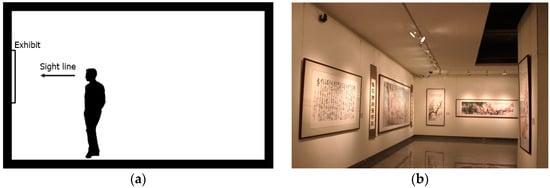
Figure 1.
Hanging display (a) Schematic diagram of exhibit arrangement; (b) Example: Guan Shanyue Art Museum.
In a flat spread display, the calligraphy and painting works are placed flat in a display case or spread on a desktop (Figure 2a). This form requires viewers to lower their heads to view the display and may cause discomfort to their neck when viewing for a long duration. Figure 2b shows the flat spread display adopted by Guangdong Museum of Art, in which long-shaped exhibition booths are set in the hall and the caricature works are displayed flat on a desktop.
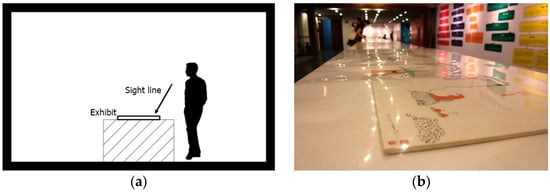
Figure 2.
Flat spread display (a) Schematic diagram of exhibit arrangement; (b) Example: Guangdong Museum of Art.
In a slanted display, the exhibit is placed in showcases with a tilted shelf, inclined relative to the ground. Compared with a flat spread display, a slanted display improves the viewing condition. However, within the field of view, the glass surface of the showcase is inclined, so the reflected images of lamps, windows and even the viewer can also be seen. Figure 3a shows a diagrammatic sketch of a slanted display, and Figure 3b is an example of a slanted display of calligraphy and painting works used by the Guangzhou Museum of Art.
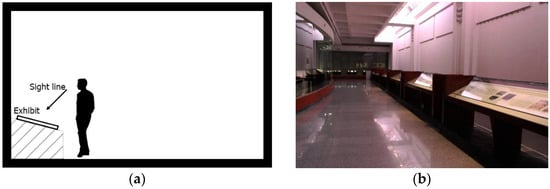
Figure 3.
Slanted display (a) Schematic diagram of exhibit arrangement; (b) Example: Guangzhou Museum of Art.
An analysis of the light environment of the calligraphy and painting exhibition hall indicated the following: (1) The key point of the light environment design has mostly focused on the effect of light on the visual presentation of calligraphy and painting works. (2) The calligraphy and painting exhibition hall of many museums are dim with only electric illuminance and no daylighting (as shown in Figure 4).
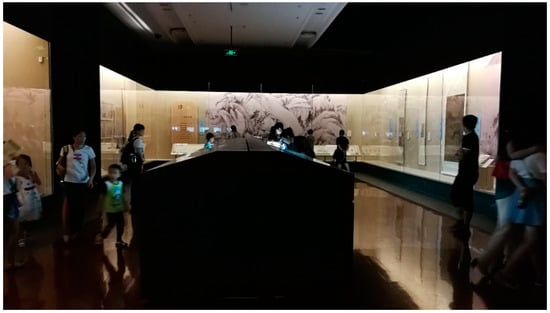
Figure 4.
Dim exhibition hall.
The light environment of the exhibition space is provided by track lighting and various lighting devices within the showcases. This dim exhibition space is a common means of displaying Chinese calligraphy and painting works, and the higher luminance contrast between the target exhibits and the background spatial environment tends to create visual fatigue. (3) In terms of light environment quality control, there is no quantitative analysis of glare, leading to inadequate glare control in the exhibition hall and widespread first and second reflected glare (Figure 5a and Figure 5b, respectively).
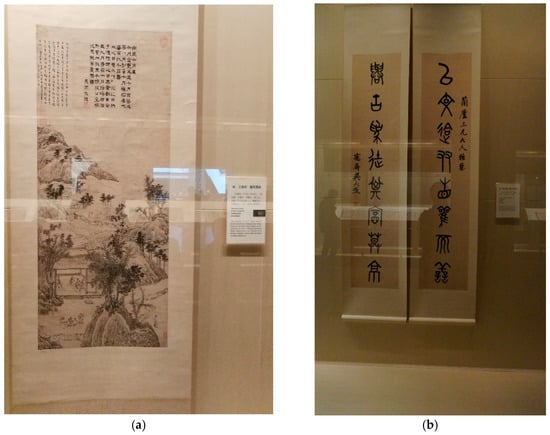
Figure 5.
Reflected glare in the exhibition hall of Chinese calligraphy and painting works. (a) First reflected glare; (b) Second reflected glare.
3. Daylighting Simulation and Daylighting Model
3.1. Simulation Method
The simulation of the daylighting environment of an exhibition space of Chinese calligraphy and painting works was conducted using the interactive collaboration mode of the light environment simulation software Radiance [20] and the analysis software Ecotect. Radiance is a building daylighting and lighting simulation software package developed by Lawrence Berkeley National Laboratory (LBNL, Berkeley, CA, USA), a national laboratory under the U.S. Department of Energy. The compute kernel of the software adopts the reverse ray tracing method based on Monte Carlo algorithm optimization, which is more suitable for accurate building daylighting analysis. Meanwhile, Ecotect is a comprehensive analysis software of building physics developed by Autodesk Company (San Rafael, CA, USA), and its’ calculation module includes: thermal environment analysis, light environment analysis, acoustic environment analysis, sunshine calculation, economic and environmental impact analysis, visibility analysis. The Ecotect software can call Radiance to perform the calculation of building daylighting.
The output and control functions of the Radiance are built in the Ecotect software, and the model data can be directly output to Radiance under Windows system to carry out accurate ray tracing calculation. The calculation contents include DF, illuminance, luminance and sky composition, and generate light environment image. For the value of DGI, the luminance image needs to be loaded into the Unix system, and the glare calculation module is used for prediction of DGI. The lighting parameters of the daylighting environment in a museum hall included the DF, DF uniformity, luminance distribution and DGI. The simulation analysis procedures are shown in Figure 6.
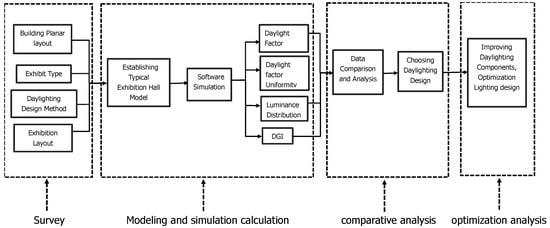
Figure 6.
Simulation procedures of daylighting design of exhibition space.
3.2. Daylighting Model
Daylighting openings are generally divided into four types according to their position on the building envelop: low side window, high side window, flat skylight, and sawtooth skylight. The exterior light through low side windows is a common daylighting form, and excessively bright side windows are prone to generate direct glare. When exhibits adopt protective glass showcases, the light through high side windows is likely to create first reflected glare, which affects the visitors’ appreciation of the exhibit. Therefore, it is necessary to appropriately adjust the positions of side windows and showcases in the exhibition hall to eliminate or mitigate glare. Rectangular exhibition halls can use strip-styled daylighting bands (flat skylights). The art pieces are hung on walls under the daylighting strip (see Figure 7 and Figure 8a), in which the strip-styled daylighting band can guide in the viewing of the artworks. In this study, the light environment simulation analysis of the exhibition space for the hanging display of calligraphy and painting works was used as an example to illustrate the optimization process of daylighting design.
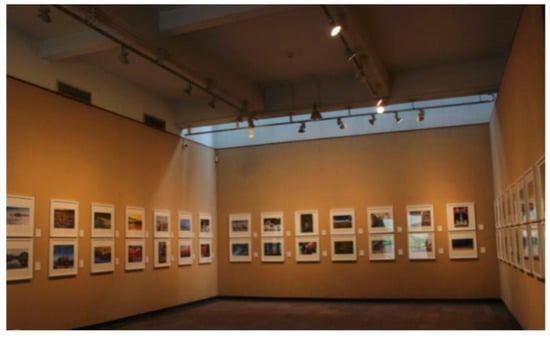
Figure 7.
Strip-styled daylighting band of exhibition hall.
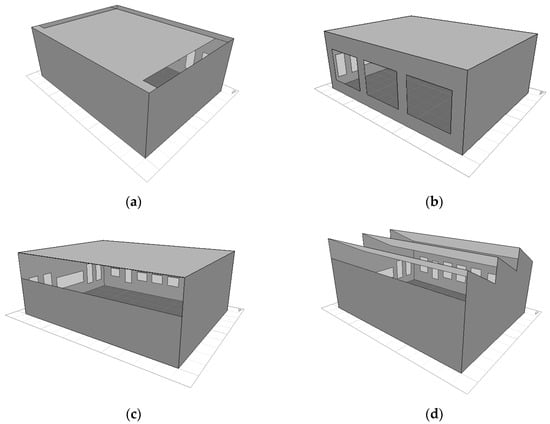
Figure 8.
Different daylighting sources of the exhibition hall: (a) flat skylight; (b) low side window; (c) high side window; (d) sawtooth skylight.
The architectural daylighting models of the 4 window types were established (Figure 8), with dimensions of 12 m × 4.5 m × 9 m (length × depth × height), in the south-north orientation. The artworks were hung on the sidewalls of the exhibition hall. In each of the window conditions, the daylighting opening parameters of the hanging display are shown in Table 1.

Table 1.
Daylighting opening parameters of the hanging display under various window conditions.
Table 2 shows the light reflectance of the inner surface of the exhibition hall. Appropriate reflection of the room’s indoor surfaces can create favorable luminance contrast which is beneficial to the visual comfort. In order to give a widely overview of approaches and parameters available to evaluate daylighting from different viewpoints, according to the visitors’ visual experience in viewing the exhibits, 12 viewpoints, numbered 1–12 clockwise from east to west (Figure 9), were set on the visiting flow line of the calligraphy and painting exhibition hall.

Table 2.
Light reflectance of the exhibition hall surfaces.
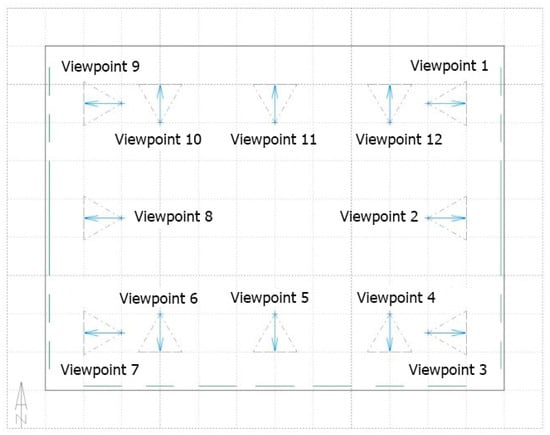
Figure 9.
Planar arrangement of viewpoints.
4. Analysis of the Light Environment Parameters
The light environment parameters of the constructed daylighting analysis model, including the DF, DF uniformity, illuminance and DGI distribution, were calculated.
4.1. DF and DF Uniformity
DF is one of the most used indices for architecture daylighting design, energy saving, and indoor visual comfort assessment. The DF definition, is the ratio of indoor daylight level at a point on the workplan (Ein) to the outdoor illuminance under an overcast sky without obstructions (Eex), and is given by:
The DF varies with the room orientation, window form and surrounding obstruction, as well as the optical phenomena like reflection, light scattering and transmission that occur across the window panes [21]. In architecture design, prediction of the DF is adopted to define sufficient internal daylighting for the dwellers, and comfort of their visual tasks [22,23].
Nowadays, daylighting design software often has a high accuracy in predicting DF. The calculation results of the DF inside the calligraphy and painting exhibition hall are shown in Figure 10. The daylighting factors of the flat skylight and the sawtooth skylights were higher than those of the low side window and the high side window. The DF of the low side window was higher when near the side window and decreased rapidly with increasing depth; as the depth increased, the DF of the high side window first slowly increased and then gradually decreased after reaching a certain position along the depth direction. Daylighting through side windows show unidirectional daylighting characteristics. Because the sawtooth skylights uniformly faced north, the indoor illuminance is also unidirectionally distributed and gradually decreased from south to north, and the areas close to the north sidewall has lower illuminance.
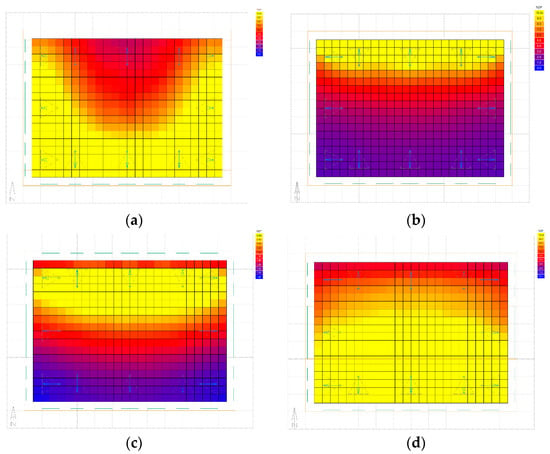
Figure 10.
Planar distribution of DFs of different types of window: (a) flat skylight; (b) low side window; (c) high side window; (d) sawtooth skylight.
Since Chinese painting and calligraphy exhibits generally must be viewed at a close distance, DF uniformity on the artwork is also a key factor in the quality of the light environment [24]. Here, the viewing area was set as an area outside the area enclosed by the connection lines of the viewpoints. The DFs and DF uniformity values of various window types in the exhibition hall are listed in Table 3. When flat skylights and sawtooth skylights were adopted, the indoor DF was higher than that of the side windows, although the DF under different window conditions met the requirement of building code. Chinese paintings and calligraphy exhibits are sensitive to light, and their aging may be accelerated under excessively high indoor illuminance. Therefore, it is necessary to control the DF. The DF uniformity values of the flat skylight and high side window were high, while those of the low side window and sawtooth skylight low, and that of the sawtooth skylight the lowest. In the viewing area, flat skylights showed the best daylighting uniformity but low overall daylighting uniformity. A large difference in DF uniformity tends to cause visual fatigue when the viewers switch their sightlines between the viewing area and the nonviewing area. High side windows showed consistent DF uniformity in viewing area and global area, leading to a more comfortable viewing experience.

Table 3.
Average DFs and uniformity values of different types of daylighting window.
4.2. Luminance Distribution
Figure 11 shows the false color map of the luminance distribution of calligraphy and painting exhibits with hanging displays, in which the luminance image of Viewpoint 5 in Figure 9 (representing the main viewing direction of the sightline) was chosen to analyze the display effect of the exhibit with various types of daylighting window. The four window types were able to produce uniform luminance on the surface of the exhibit and ensure that the luminance of the exhibit was slightly higher than that of the background wall, thus highlighting the exhibit. In the cases of daylighting through the low and high side windows, the luminance of the surface of the exhibit was low, while in the cases of daylighting through the skylights, the luminance of the surface of the exhibit was high.
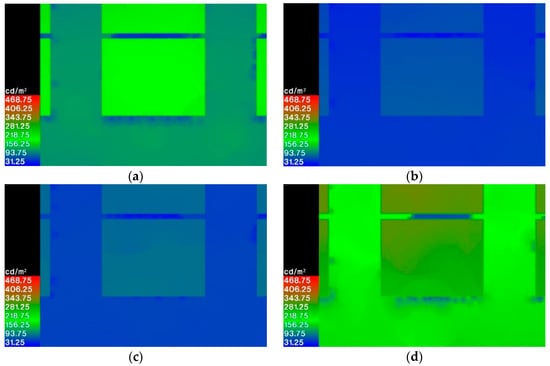
Figure 11.
The luminance distribution at Viewpoint 3 of daylighting through different window types: (a) flat skylight; (b) low side window; (c) high side window; (d) sawtooth skylight.
4.3. DGI
The definition of glare is “the sensation produced by luminance within the visual field that is sufficiently greater than the luminance to which the eyes are adapted to cause annoyance, discomfort, or loss in visual performance and visibility” [25]. And, the discomfort glare index (DGI) of a window is calculated by [3,26]:
where:
where Gn is the glare constant; Ls is the luminance of each window, i.e., the weighted average luminance (cd/m2) of the sky, obstructive objects and ground visible through the window; Lb is the background luminance, which is the average luminance of the surfaces (cd/m2) within the observer’s field of view; Ω is the solid angle of modified window as a function of sight line (sr):
where ω (see Figure 12) is the solid angle (sr) formed by the window to the calculation point; p is the Guth position index, which is related to the transverse and longitudinal tangent function values from the viewer to the light source, and p can be calculated by:
in which α is the angle between the window diagonal and the vertical direction of the window; and β is the angle between the line connecting the observer’s eyes and the center point of the window and the line of sight direction, angles α and β are shown as Figure 12.
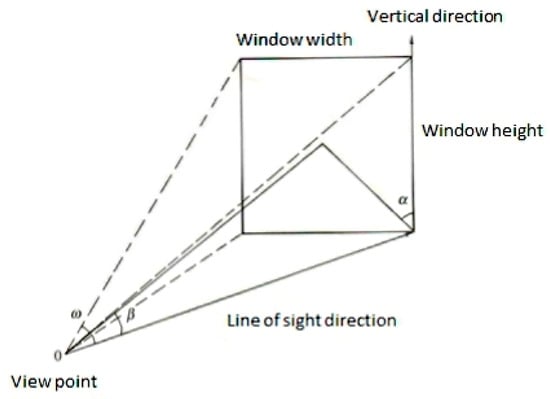
Figure 12.
The scheme that displays the angles α, β and solid angle ω.
The calculated DGI value of each viewpoint is shown in Figure 13. The analysis of the DGI curve of the daylighting of each window type shown in Figure 13 indicates that the DGI values of all the viewpoints of the four window types did not exceed the standard value, and the DGI curve of the flat skylight was smooth, i.e., the variation in the glare values of the viewpoints was relative small. For daylighting through skylights, the visual perception of each viewpoint was more consistent, while the DGI value of the viewpoint fluctuated more profoundly when daylighting through other window types.

Figure 13.
DGI values of the exhibition hall under various conditions.
In the case of daylighting through the low side window, when the line of sight was across from the window (Viewpoints 10–12) or back toward the window (viewpoints 4–6), the glare value was 0, and the DGI value of each viewpoint fluctuated significantly during the viewing process. For daylighting through the sawtooth skylight, Viewpoints 10–12 showed a high DGI with large fluctuation. For daylighting through the high side window, the pattern of change of the DGI curve was similar to that for daylighting through the low side window but with slightly smaller fluctuation.
5. Optimization Analysis
5.1. Optimization of the Daylighting Form
The reasonable daylighting form of the exhibition hall of Chinese calligraphy and painting works was determined by comparing and analyzing the light environment parameters of each viewpoint under each daylighting form. Chinese calligraphy and painting exhibits are sensitive to light, and flat skylights are directly above the exhibits, causing a large amount of daylight value to directly irradiate the surface of the exhibits. Using this form of daylighting, it is difficult to control the quantity of illumination and the exhibits may deteriorate in solarization condition. For daylighting through low side windows, the luminance uniformity and the luminance on the surface of the exhibit were low. The analysis of the daylighting parameters indicates that daylighting through flat skylights or high side windows was more suitable for an exhibition hall adopting a hanging display of Chinese painting and calligraphy works. High side windows generate favorable illuminance uniformity in both the viewing area and the entire exhibition hall, with gentle indoor light and low DGI value. Therefore, daylighting through high side windows is suitable for the exhibition of Chinese calligraphy and painting works.
5.2. Daylighting Component Optimization
After determining the adoption of daylighting through high side windows, it is found that the DF uniformity in the viewing area and the overall area was poor. This result occurs because daylighting through side windows is highly directional and leads to low illuminance in areas far away from windows, so it is necessary to introduce more light into these areas when taking optimization measures. To achieve this goal, protruding windows with an overhang of 0.9 m (Figure 14) were designed for these high side windows, and high reflection coating on the protruding inner surface of the high side window sill (with a illuminance reflectance of 0.91), which could reflect the outdoor light to the ceiling and thus reach the depths of the hall. The DF uniformity and DGI values of a high side window before and after the optimization are shown in Table 4 and Figure 15.
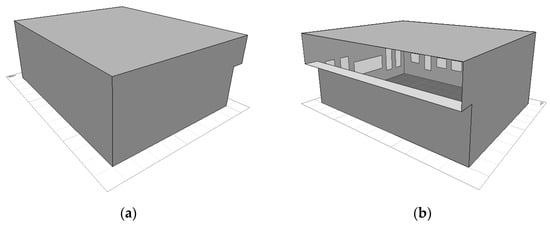
Figure 14.
Optimization of high side windows of the exhibition hall: (a) back side view; (b) front side view.

Table 4.
The DFs and DF uniformity values of the daylighting scheme using a high side window before and after optimization.
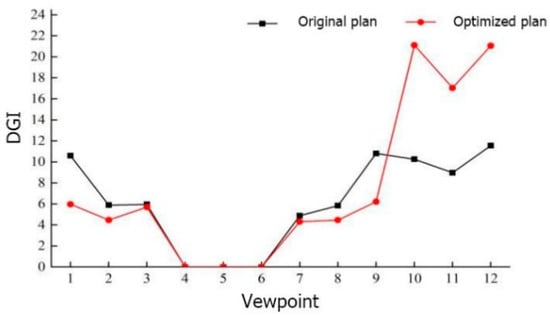
Figure 15.
The DGI values of daylighting through high side windows before and after the optimization scheme.
Table 4 and Figure 15 show that after adopting the optimized scheme using protruding high side windows, the indoor average DF was reduced by 28.3%, from 4.74% to 3.04%, and the illuminance of the overall space decreased but still met the requirements of building code while increasing the protection of the calligraphy and painting exhibits. In terms of illuminance uniformity, the illuminance uniformity of the viewing area was increased by 31%, from 0.422 to 0.553, while the overall luminance uniformity was increased by 26%, from 0.407 to 0.513. The luminance distribution of the exhibition hall was more even, significantly improving viewers’ visual comfort.
Figure 15 shows that for the optimized scheme, except for viewpoints 10–12, the DGI value of each viewpoint decreased, with reduced fluctuation and more consistent visual perception. Viewpoints 10–12, located on the side of high side windows, had a high DGI value, which was even higher than the upper limit value (20) and caused glare because the protruding high side window increased the luminance contrast between the wall and the window. When viewers viewed the exhibits hanging right underneath the window, the luminance on the exhibit was relatively low, while that of the window was too high, and the high luminance contrast occurs in visual field. Thus, when displaying exhibits below a high side window, spotlights on the exhibit should be arranged to reduce the luminance contrast on the surface of the exhibit.
6. Discussion
The study emphasized how daylighting design strategies to ensure visual comfort in exhibition halls of museums for Chinese calligraphy and painting works and proper type of windows are closely related to the evaluation of natural lighting. Through a survey of the daylighting status of museums, we categorized exhibition spaces and determined various parameters, such as the DF, DF uniformity, luminance distribution, and DGI value, of an exhibition hall of Chinese calligraphy and painting works under different window conditions. After comparing and analyzing the daylighting environments of various types of windows, we performed a comprehensive evaluation on the daylighting quality of the exhibition space under various window conditions and determined an optimal daylighting form for a hanging display of calligraphy and painting exhibits. In a hanging display of Chinese calligraphy and painting works, when the daylighting scheme of high side windows is adopted, the high side window is designed as a convex window, and the light reflection along the protruding surface of the window sill is used to improve the illuminance value in the depths of the room and, thus, the uniformity of the luminance in the exhibition hall. And, in terms of glare control, the DGI values of most viewpoints in the viewing area decreased and tended to stabilize. However, the DGI values of the viewpoints that faced the high side window were high and tended to generate glare, so spotlights should be provided to improve the illuminance of this area of the exhibition wall, reduce luminance contrast and thus eliminate glare. On the other hand, if the exhibit is placed in showcases, it may give rise to the first and second reflected glare on the surfaces on the glass enclosing the exposed Chinese calligraphy and painting works. Adjust the position between a window and a showcase can avoid first reflection; remove the reflected image from visual field or decrease the brightness of the second reflection, may reduce the second reflection. In this way, the lighting environment quality of a calligraphy and painting exhibition hall can be improved by optimizing light environment parameters, improving daylighting uniformity, and mitigating glare through daylighting design.
7. Conclusions
In this study, we described the process of optimizing a museum daylighting design using a quantitative method and proposed a corresponding daylighting optimization strategy for a display space. Through this strategy, the tailored daylighting design is developed according to the characteristics of Chinese calligraphy and painting works, the exhibition layout and the architectural environment, so the exhibition space can have a suitable daylighting environment and museum fatigue syndrome can be avoided to some extent.
Author Contributions
Conceptualization, X.H.; methodology, X.H.; investigation, X.H., S.W. and S.Z.; writing—original draft preparation, X.H. and S.W.; writing—review and editing, X.H.; visualization, S.W. and S.Z.; supervision, X.H.; project administration, X.H.; funding acquisition, X.H. All authors have read and agreed to the published version of the manuscript.
Funding
This research was funded by National Natural Science Foundation of China, grant number 51568003.
Conflicts of Interest
The authors declare no conflict of interest.
References
- Liu, X.; Chen, Y.; Wu, B.; Xie, S.; Wang, L. Research on the light environment of the contemporary art museum—Taking the today art museum as an example. China Illum. Eng. J. 2018, 29, 38–44. [Google Scholar]
- Hefferan, S. Working with daylight in the museum environment. WAAC Newslett. 2008, 30, 22–24. [Google Scholar]
- Galatioto, A.; Beccali, M. Aspects and issues of daylighting assessment: A review study. Renew. Sustain. Energy Rev. 2016, 66, 852–860. [Google Scholar] [CrossRef]
- Wang, L. Application and Research of Visual Conditions in Museum Exhibition Design Light Environment. Master’s Thesis, Xi’an University of Architecture and Technology, Xi’an, China, 2013. [Google Scholar]
- Saraiji, R.; Al, Y.; Safadi, M.; Al, G.N.; Mistrick, R.G. A comparison of scale-model photometry and computer simulation in day-lit spaces using a normalized daylight performance index. Energy Build. 2015, 89, 76–86. [Google Scholar] [CrossRef]
- Fasi, M.; Budaiwi, I. Energy performance of windows in office buildings considering daylight integration and visual comfort in hot climates. Energy Build. 2015, 108, 307–316. [Google Scholar] [CrossRef]
- Wonuk, K.; Yongseok, J.; Yongchan, K. Simulation-based optimization of an integrated daylighting and HVAC system using the design of experiments method. Appl. Energy 2016, 162, 666–674. [Google Scholar]
- Pinilla, S.M.; Moliní, D.V.; Fernandez-Balbuena, A.A.; Raboso, G.H.; Herraez, J.A.; Azcutia, M.; Botella, A.G. Advanced daylighting evaluation applied to cultural heritage buildings and museums: Application to the cloister of Santa Maria El Paular. Renew. Energy 2016, 85, 1362–1370. [Google Scholar] [CrossRef]
- Hee, W.J.; Alghoul, M.A.; Bakhtyar, B.; Omkalthum, E.; Shameri, M.A.; Alruaih, M.S.; Sopian, K. The role of window glazing on daylighting and energy saving in buildings. Renew. Sustain. Energy Rev. 2015, 42, 323–343. [Google Scholar] [CrossRef]
- Acosta, I.; Munoz, C.; Campano, M.A.; Navarro, J. Analysis of daylight factors and energy saving allowed by windows under overcast sky conditions. Renew. Energy 2015, 77, 194–207. [Google Scholar] [CrossRef]
- Altomonte, S.; Kent, M.G.; Tregenza, P.R.; Wilson, R. Visual task difficulty and temporal influences in glare response. Build. Environ. 2016, 95, 209–226. [Google Scholar] [CrossRef]
- Collinge, W.O.; Landis, A.E.; Jones, A.K.; Schaefer, L.A.; Bilec, M.M. Productivity metrics in dynamic LCA for whole buildings: Using a post-occupancy evaluation of energy and indoor environmental quality trade-offs. Build. Environ. 2014, 82, 339–348. [Google Scholar] [CrossRef]
- Osterhaus, W.K.E. Discomfort glare assessment and prevention for daylight applications in office environments. Sol. Energy 2005, 79, 140–158. [Google Scholar] [CrossRef]
- Sharp, F.; Lindsey, D.; Dols, J.; Coker, J. The use and environmental impact of daylighting. J. Clean. Prod. 2014, 85, 462–471. [Google Scholar] [CrossRef]
- Boubekri, M. Daylighting, Architecture and Health: Building Design Strategies, 1st ed.; Elsevier Ltd.: Oxford, UK, 2008. [Google Scholar]
- Tregenza, P.; Wilson, R. Daylighting, 1st ed.; Routledge: Oxon, UK, 2011. [Google Scholar]
- Matusiak, B.S. Glare from a translucent facade, evaluation with an experimental method. Sol. Energy 2013, 97, 230–237. [Google Scholar] [CrossRef]
- Huang, X.; Wei, S. Optimization strategy to day-lighting design of exhibition spaces within a museum. J. Civ. Archit. Environ. Eng. 2018, 40, 94–102. [Google Scholar]
- Tang, M.; Liu, M.; Zhang, B.; Luo, T.; Han, Y.; Zhang, T. Simulation study of the light environment of the museum’s direct sunlight area—Take the west hall of the national museum of china as an example. China Illum. Eng. J. 2019, 30, 119–124. [Google Scholar]
- Zhou, S.; Wang, Y.; Ye, X.; Liu, B. Study on natural lighting design parameters of residential building grooves in Chongqing. Build. Sci. 2016, 32, 151–154, 158. [Google Scholar]
- Geebelen, B.; van der Voorden, M.; Neuckermans, H. Fast and accurate simulation of long-term daylight availability using the radiosity method. Lighting Res. Technol 2005, 4, 295–312. [Google Scholar] [CrossRef]
- Calcagni, B.; Parroncini, M. Daylight factor prediction in atria building designs. Sol. Energy 2004, 76, 669–682. [Google Scholar] [CrossRef]
- Greenup, P.J.; Edmonds, I.R. Test room measurements and computer simulations of the micro-light guiding shade daylight redirecting device. Sol. Energy 2004, 76, 99–109. [Google Scholar] [CrossRef]
- Carlucci, S.; Causone, F.; De Rosa, F.; Pagliano, F. A review of indices for assessing visual comfort with a view to their use in optimization processes to support. Renew. Sustain. Energy Rev. 2015, 47, 1016–1033. [Google Scholar] [CrossRef]
- GB/T 50033-2013, Design Standard for Building Daylighting; China Architecture & Building Press: Beijing, China, 2013.
- Nazzall, A. A new evaluation method for daylight discomfort glare. Int. J. Ind. Ergon. 2005, 35, 295–306. [Google Scholar] [CrossRef]
© 2020 by the authors. Licensee MDPI, Basel, Switzerland. This article is an open access article distributed under the terms and conditions of the Creative Commons Attribution (CC BY) license (http://creativecommons.org/licenses/by/4.0/).